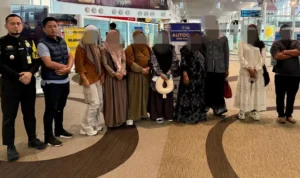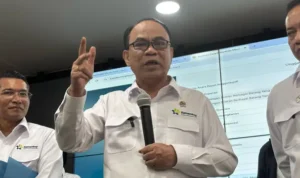INDONESIAUPDATES.COM, News En – Nepal is grappling with a major natural disaster as powerful flash floods and landslides have swept through several regions of the country. Days of torrential rain have caused rivers to overflow, triggering floods that have destroyed homes, bridges, and vital infrastructure. Additionally, landslides in mountainous areas have buried villages and cut off access to remote regions.
Dozens Killed and Thousands Threatened
As of now, at least 60 people have been reported dead due to the floods and landslides, with dozens more still missing, according to local authorities. The death toll is expected to rise as rescue teams struggle to reach hard-hit areas that remain inaccessible.
“The situation is extremely concerning. We have reports of entire villages being buried by landslides, and rivers are rising rapidly, making evacuations increasingly difficult,” said a spokesperson for Nepal’s Ministry of Home Affairs.
Severe Infrastructure Damage
Images from the disaster areas reveal widespread destruction. Major roads connecting isolated regions have been cut off, and several crucial bridges have been swept away by the powerful river currents. Thousands of residents have been forced to flee to safer areas, though many remain trapped in their homes, awaiting rescue.
The Nepalese government has deployed search and rescue teams, including the military, to aid in evacuation and recovery efforts. However, the challenging terrain and continuing rain have hampered these operations. Rescuers are working to evacuate survivors and deliver essential supplies, such as food, clean water, and medicine, to the hardest-hit areas.
Extreme Weather Challenges
Nepal is no stranger to natural disasters like floods and landslides, particularly during the monsoon season. However, this year’s unusually heavy rainfall has exacerbated the situation. Climate experts warn that climate change could worsen extreme weather patterns in the region, increasing the frequency and severity of natural disasters.
International Aid and Humanitarian Response
Several international organizations have offered assistance, including United Nations agencies and humanitarian groups. They are coordinating with the Nepalese government to dispatch emergency aid and medical teams to the affected regions. However, logistical challenges and widespread infrastructure damage have made the delivery of aid difficult.
“Our top priority is saving lives and providing basic necessities to those affected. We are closely monitoring the situation as the risk of further flooding and landslides remains very high,” said a representative from the International Federation of Red Cross and Red Crescent Societies (IFRC).
Government Warnings for Residents
The Nepalese government has issued urgent warnings for residents in high-risk areas to evacuate immediately. Experts are cautioning that the ground in several regions is saturated with water, making additional landslides highly likely.
Amid this disaster, international solidarity and a swift response from authorities are crucial to saving lives and mitigating further impacts. Nepal remains in a state of emergency as relief efforts continue, with heavy rainfall expected to persist in the coming days.
FAQ: Devastating Flash Floods and Landslides in Nepal
- What caused the floods and landslides in Nepal?
The floods and landslides were triggered by days of torrential rain, causing rivers to overflow and landslides to occur in mountainous regions. The intense rainfall overwhelmed drainage systems and destabilized the terrain, leading to widespread destruction. - How many people have been affected?
So far, at least 60 people have been reported dead, with dozens more missing. Thousands of people are displaced or trapped in their homes, with rescue efforts still underway. - Which areas in Nepal are most affected?
The mountainous regions of Nepal, as well as riverbank areas, have been hit the hardest. Several remote villages have been buried by landslides, and access to these regions is severely limited due to damaged infrastructure. - What kind of damage has been caused by the floods and landslides?
Significant damage has been reported, including the destruction of homes, bridges, and roads. Vital infrastructure like communication networks and transportation routes have been disrupted, making it difficult for rescue teams to reach affected areas. - What is the Nepalese government doing to respond to the disaster?
The Nepalese government has deployed search and rescue teams, including military personnel, to assist in evacuation and recovery efforts. They are also working to provide essential supplies such as food, water, and medical aid to the affected regions. - Are international organizations providing assistance?
Yes, several international organizations, including United Nations agencies and humanitarian groups like the International Federation of Red Cross and Red Crescent Societies (IFRC), are coordinating with the Nepalese government to deliver aid and support rescue operations. - What challenges are rescue teams facing?
Rescue teams are dealing with severe logistical challenges, such as damaged roads, washed-out bridges, and ongoing heavy rainfall. The terrain in some areas is difficult to navigate, further complicating the delivery of aid and evacuation efforts. - Is there a risk of more floods and landslides?
Yes, experts warn that the saturated ground and continued rainfall increase the likelihood of further landslides and flooding in the coming days. The government has urged residents in high-risk areas to evacuate. - What measures are being taken to prevent future disasters like this?
In the long term, Nepal may need to invest in improved infrastructure, early warning systems, and disaster preparedness to mitigate the impacts of such natural disasters. Climate change is also a growing concern, as it may lead to more frequent and severe weather events in the region. - How can people help those affected by the floods and landslides in Nepal?
People can support relief efforts by donating to reputable humanitarian organizations working on the ground in Nepal, such as the Red Cross, UNICEF, or other trusted charities providing aid and assistance to the affected communities.
FOLLOW INDONESIAUPDATES.COM ON GOOGLE NEWS






